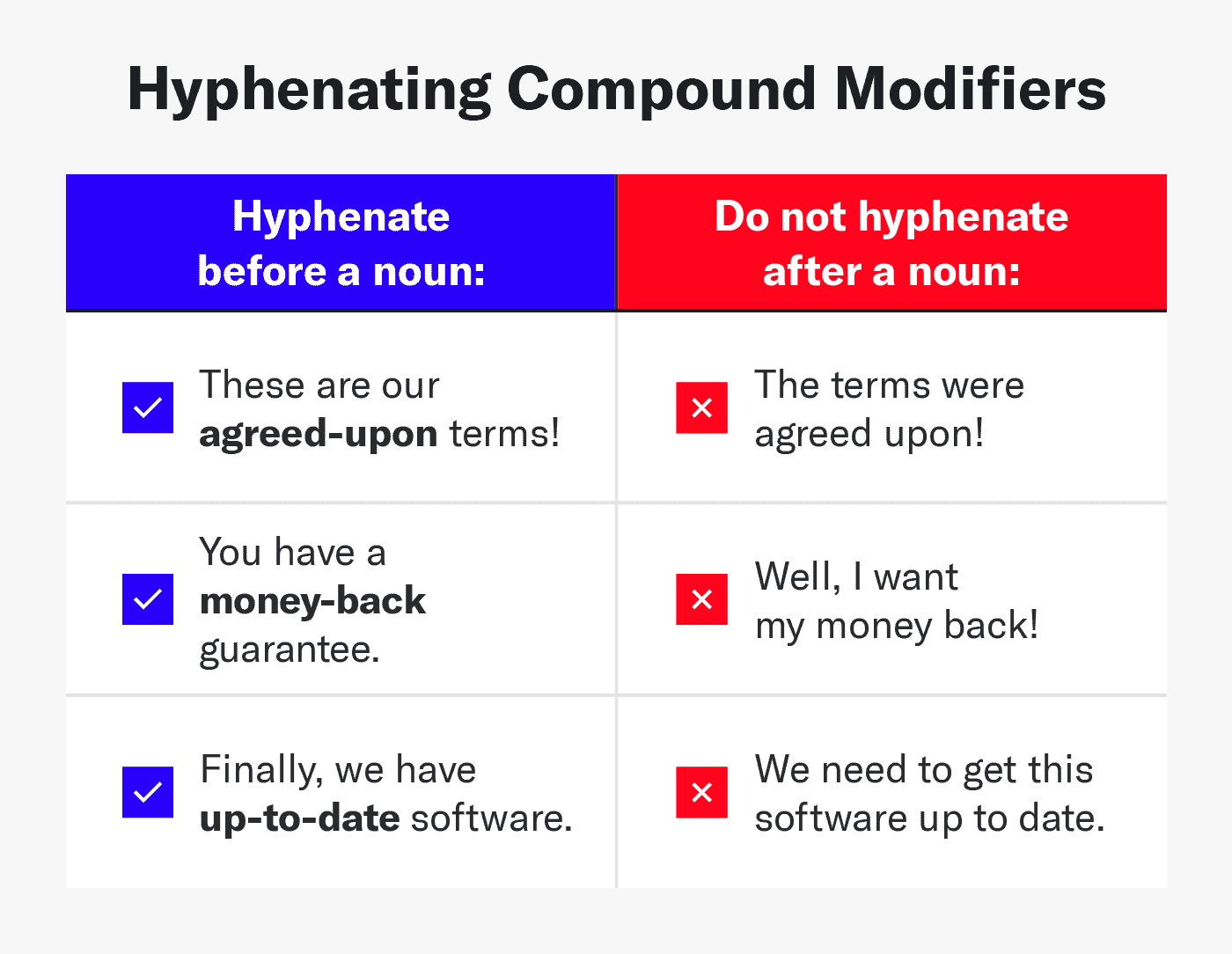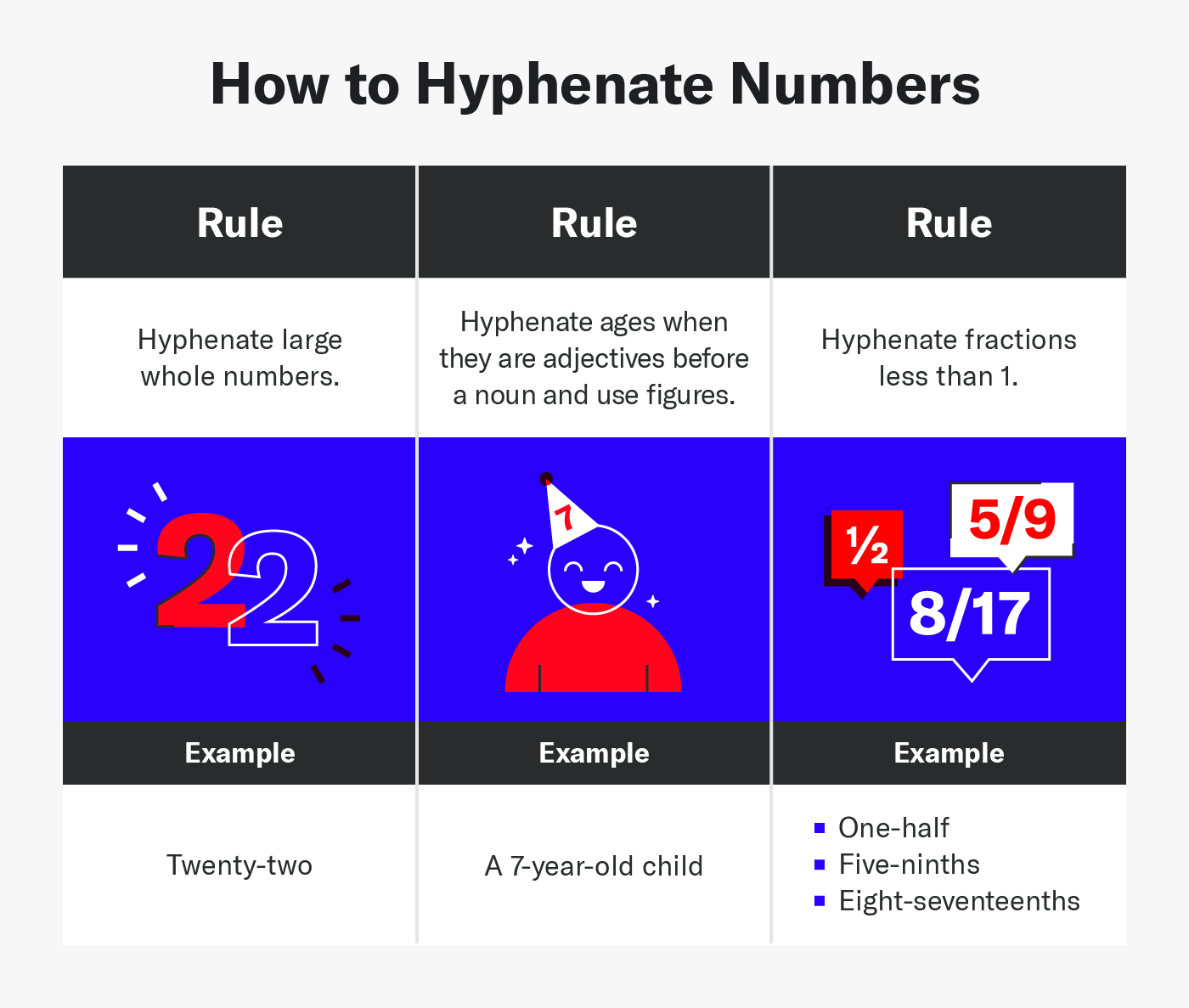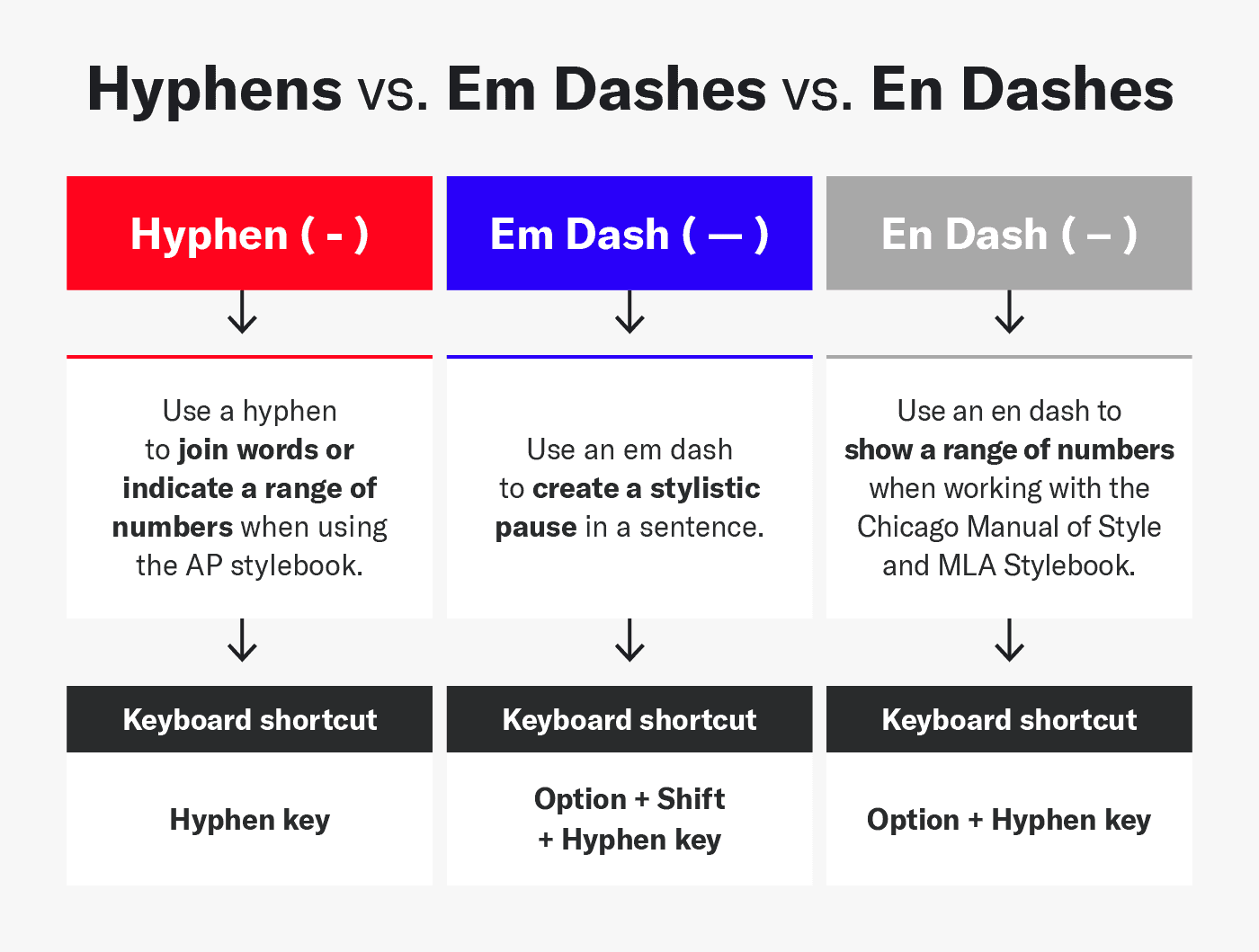That is the question. At least it is on my mind every day as an editor. As content writers and editors, we waste too much time combing through SERPs to figure out if a specific word is hyphenated or not (and the results … vary).
The best content marketing agencies have teams of content marketing professionals — from writers and editors to managers and SEO specialists — to ensure their customers have top-of-the-line content.
But let’s not drag out this intro too much. Bookmark this page and reference our hyphenation guide when you encounter these common content marketing terms (and other words I’ve Googled throughout the years).
- Hyphen Basics
- Hyphens vs. Em Dashes vs. En Dashes
- Does Hyphenation Affect SEO
- Hyphenating Common Terms + Hyphen Glossary
- How To Hyphenate SaaS Terms
- How To Hyphenate Fintech Terms
- How To Hyphenate E-commerce Terms
- Additional Hyphenation Rules
Hyphen Basics
Hyphenation is one of the trickiest punctuation nuances to learn, and it feels like its rules are always in flux. And for content writers and editors working in ever-changing industries like fintech, SaaS, and e-commerce, new terms pop up every year, like spring flowers. So it’s always essential to refresh your content regularly — or whenever industries evolve.
Luckily, there are a few essential hyphenation rules to know when you wonder, “Wait…is this word hyphenated or not?” Here are some basics:
Hyphenate compound modifiers before a noun:
When two words form a single thought, they are known as compound modifiers, and you should hyphenate them before a noun. You usually do not need to hyphenate them after a noun.
Let’s take a look at the rules for the big three stylebooks that editors will most often reference:
- AP Stylebook says: Do use a hyphen if it’s needed to make the meaning clear and avoid unintended meanings: small-business owner, better-qualified candidate, little-known song, French-speaking people, free-thinking philosophy, loose-knit group, low-income workers, never-published guidance, self-driving car, bases-loaded triple, one-way street.
- Chicago Says: Hyphenate compound adjectives before a noun.
- MLA Says: A general principle is that two words forming an adjective before a noun use a hyphen, [and] two words forming an adjective after a noun do not.
Tip: Abbreviations represent a single word in compound modifiers, so you will also hyphenate them when they come before a noun:
- This is an FDA-approved drug.
- It deals with U.S.-Mexico relations.
Hyphenate Compound Modifiers After a “To Be” Verb
According to the AP Stylebook, you may also usually hyphenate a compound modifier after a verb form of “to be” when you need to avoid confusion in the sentence. Take the compound modifier “cutting edge” as an example here.
- Before a noun: The cutting-edge software was elite.
- As a noun: The software is on the cutting edge.
- A compound modifier after a form of “to be”: The software is cutting-edge.
Rules for Hyphenating Adverbs
You do not need a hyphen when writing a compound modifier where one word is:
- Very
- It’s a very fine dinner.
- An adverb that ends in -ly
- This isn’t an environmentally friendly plastic.
- She is a brutally honest judge.
- It’s a mutually exclusive process.
This may seem like a confusing rule because surely those adverbs are part of the compound modifier, right? Well, not necessarily. An adverb is a tricky function that modifies another nearby modifier or verb. (OK, take a deep breath with me. You got this).
Let’s dissect our sentences from above:
- “Very” modifies “fine,” which modifies “dinner.”
- “Environmentally” modifies “friendly,” which modifies “plastic.”
- “Brutally” modifies “honest,” which modifies “judge.”
Compare these to compound modifiers, where only the noun is modified by two words in the sentence. You will say, “These are our agreed-upon terms,” because “agreed” still modifies “terms,” even though there’s another word between them.
You got that? Is your brain feeling scrambled? Mine too! But these are essential rules to know to create high-quality content that converts. Also, it’s okay to just do a command+F for the terms you’re looking for if you don’t want to get into the weeds with me! Let’s move on.
Number Hyphenation Rules
When I’m not referencing my various style guides for hyphenation rules, I’m probably on the page that explains number guidelines. Put the two of them together, and it’s all too possible to have an extremely confusing situation on your hands.
Luckily for all of us, hyphenation rules for numbers are fairly easy to remember. Check it out:
- Hyphenating whole numbers: Hyphenate large whole numbers like twenty-one, eighty-seven, and one hundred twenty-five. But this is only for rare cases or at the beginning of sentences.
- Hyphenating fractions: Hyphenate all fractions below zero, like one-fourth, two-ninths, and eight-seventeenths. For fractions larger than 1, use decimals. When writing the colloquial phrase “and a half” after an age, use spaces.
- Hyphenating ages: Hyphenate ages when used as an adjective before a noun and use figures for the age. For example, the boy is 11 years old, and he has a 7-year-old sister.
Suspended Compound Hyphens
When a single subject has multiple modifiers in front of it, you can use a suspended hyphen instead of repeating the subject in a sentence. This will help you write with concision:
- It was a first-, second-, and third-course meal.
- It’s a water-, heat-, and pest-resistant drywall.
The 3-Letter Rule
When you’re writing a compound modifier where three consecutive letters occur, it’s best practice to hyphenate the term to ensure readability. The sentence, “We are successful at crossselling,” is hard to read. It’s easier for an audience to read the grammatically correct version, “We succeed at cross-selling.”
Hyphenation for Title Case Headers
When dealing with a client that uses title case, I’ll often have to rummage through my various style guides to see how to accurately capitalize hyphenated words. Is it grammatically correct to say “Best-in-class” or “Best-In-Class”? Unfortunately, the answer isn’t as concrete as it should be.
While the AP Stylebook and Chicago Manual of Style recommend capitalizing multiple words in a hyphenated title, many clients prefer to see them in lowercase. In this case, turn to your client when you wonder if it’s okay to capitalize hyphenated words in headers.
If they are slow to respond, put your editing cap on and look at their previous blog posts to see if there’s existing evidence of their preferred style.
Hyphens vs. Em Dashes vs. En Dashes
One of the most common questions I receive as an editor, besides whether something is hyphenated or not, is about the differences between hyphens, em dashes, and en dashes.
Long story short, there are too many dashes. But they all serve a unique function, so let’s cover how to tell the difference, going from shortest to longest:
- Hyphens ( – ) are the shortest of the three main dashes. You will primarily use hyphens to join two or more words, compound modifiers, fractions, and whole numbers. When following the AP Stylebook, you will also use hyphens for number ranges.
- En dashes ( – ) are the most rarely used dash on this list. You will primarily use them for number ranges while working with the Chicago Manual of Style and MLA. AP does not use the en dash in any form. MLA also uses the en dash for open compounds, which are compounds that aren’t immediately followed by a noun (the University of Nebraska–Omaha, for example).
- Em dashes ( — ) are common in all kinds of writing, from journalism to fiction. You will use em dashes to create a stylistic pause in your writing or signal a change of thought. The AP stylebook uses spaces around em dashes, while MLA and the Chicago Manual of Style don’t use spaces. However, many businesses that use AP style don’t like this rule, so double-check your client’s style guide before editing.
Does Hyphenation Affect SEO?
Hyphens do affect SEO and search volume — but on a case-by-case basis. Google is an ever-learning algorithm that will provide different results based on your search intent.
While the SERP shows the same top-ranking results for “king-size mattress” and “king size mattress,” the grammatically correct form (with the hyphen — it’s a compound modifier, after all) produces 50.8 million results, while the one without the hyphen shows 41.1 million as of this writing.
Hyphenating Common Terms + Hyphen Glossary
*All words highlighted in red are incorrect forms. We included them in the chart for command+F or ctrl+F purposes.
| Word | Rule | Example |
|---|---|---|
| Add-on or Add on | Hyphenated as a compound noun and adjective. Not hyphenated as a verb. |
|
| Agreed-upon or Agreed upon | Hyphenate when it’s a compound modifier. |
|
| And-a-half or And a half | Do not hyphenate the colloquial term. Only hyphenate the proper fraction: one-half. |
|
| Backup, Back up, or Back-up | Written as one word as a noun and verb. Use spaces when it’s a verb. |
|
| Brand-new or Brand new | Always hyphenated as an adjective. |
|
| Business-to-business or business to business (also: business-to-consumer) | Always hyphenate whether it’s an adjective or noun. |
|
| Call-to-action or call to action | Only hyphenated as a compound modifier before a noun. |
|
| Customer-to-customer or customer to customer | Always hyphenate as a noun and modifier. |
|
| Cutting-edge or Cutting edge | Hyphenate as a compound modifier. Hyphenate when it follows a form of “to be.” Do not hyphenate the noun. |
|
| Day-to-day or Day to day | Hyphenate when it’s a compound modifier before a noun. |
|
| Decision-makers or decision makers | Hyphenated as a compound noun or adjective. |
|
| Decision-making or decision making | A compound noun and adjective — always hyphenate. |
|
| Double-check or Double check | A hyphenated verb. |
|
| Drag-and-drop or Drag and drop | Hyphenated as an adjective. Use spaces for the verb.Never spell it as “drag-n-drop” or “drag n drop” unless specifically requested. |
|
| Easy-to-use or Easy to use | Hyphenate when it’s a compound modifier before a noun. |
|
| Empty-handed or empty handed | A hyphenated adjective, no matter its place in a sentence. |
|
| End-to-end or End to end | Hyphenate when it’s a compound modifier before a noun. |
|
| End-users or End users | Hyphenate the compound modifier before the noun. Use spaces for the noun form. |
|
| Entry-level or entry level | Hyphenate when it’s a compound modifier. Spaces when it functions as a noun or follows a noun. |
|
| Face-to-face or Face to face | Always hyphenate. |
|
| Farm-to-table or farm to table | Phrasal noun; always hyphenated. |
|
| Fine-tune or fine tune | A hyphenated verb. |
|
| Flare-up or Flare up | Hyphenated noun. Use a space for the phrasal verb. |
|
| Follow-up or follow up | Hyphenated noun. Use a space for the verb form. |
|
| Forward-thinking or forward thinking | Always hyphenate. |
|
| Hole-in-one or hole in one | Merriam Webster: An unhyphenated noun phrase. AP Style: Always hyphenated. |
|
| Ill-will or Ill will | Hyphenated when you conjugate the verb. |
|
| In-sync or in sync | An idiom. Never hyphenated. |
|
| In-the-know or in the know | Unhyphenated noun phrase. |
|
| Jump-start or jump start (also: Jump-started or jump-starting) | A hyphenated transitive verb. |
|
| Lead-in or lead in | Always hyphenated as a noun and adjective. |
|
| Little-to-no or little to no | A determiner, not an adjective — never hyphenate. |
|
| Mom-and-pop shop or Mom and pop shop | A common idiom + noun. Always hyphenated. |
|
| Money-back or money back | Hyphenate when it’s a compound modifier before a noun. |
|
| Multiple-choice or multiple choice | Hyphenate when it’s a compound modifier. |
|
| Mutually-exclusive or mutually exclusive | Never hyphenated as a compound modifier. |
|
| Nine-to-five or Nine to five | Always hyphenated as a noun and compound modifier. |
|
| Note-taking or Note taking | A hyphenated noun and compound modifier. |
|
| One-on-one or One on one | Hyphenated noun and adjective. |
|
| One-size-fits-all or One size fits all | Always hyphenated. |
|
| One-stop-shop, One-stop shop, or One stop shop | Hyphenate “one-stop.” It is never “one-stop-shop.” |
|
| Out-of-the-box or Out of the box | Hyphenate as a compound modifier. |
|
| Out-think or Outthink | A transitive verb that is never hyphenated. |
|
| Pop-up or Pop up | Hyphenated as a noun or adjective. Never hyphenated as a verb. |
|
| Problem-solving or Problem solving | Hyphenated as a verb and adjective. |
|
| Real-time or real time | Hyphenated as an adjective. Use spaces when it’s a noun. |
|
| Risk-taking or risk taking | A hyphenated noun. |
|
| Role-play, roleplay, or role play | A hyphenated transitive verb. Less commonly seen as a single word. |
|
| Second-guess or second guess | A hyphenated transitive verb. |
|
| Second-hand, secondhand, or second hand | Never hyphenated. A single word when used as an adjective or adverb. |
|
| Send-off or send off | A hyphenated noun. |
|
| Shake-up, shakeup, or shake up | A hyphenated noun. Use spaces as a verb. |
|
| State-of-the-art or state of the art | A hyphenated noun phrase. |
|
| Step-by-step or step by step | Hyphenated as an adjective or adverb. Not hyphenated as a noun. |
|
| Step-up or step up | Hyphenated as a noun. Use a space to write the verb form. |
|
| Take-home pay or take home pay | Hyphenated noun. |
|
| Third-party or third party | Hyphenated as a compound modifier. |
|
| Time-consuming or time consuming | A hyphenated adjective. |
|
| Top-ranking or top ranking | A hyphenated adjective. |
|
| Trade-in or trade in | A hyphenated adjective and noun. Use spaces for the transitive verb. |
|
| Two-factor authentication or two factor authentication | A compound modifier that’s always hyphenated. |
|
| Upside-down or upside down | Hyphenated as an adjective. Not hyphenated as an adverb. |
|
| Up-to-date or up to date | Hyphenate as a compound modifier. |
|
| Vacuum-sealed or vacuum sealed (also: Vacuum-packed) | Always hyphenate as a verb and adjective. |
|
| Well-being, well being, or wellbeing | Always hyphenated, never one word. |
|
| White-label or white label | The rules fluctuate. Check your style guide! | |
| Wi-Fi, Wifi, or Wi Fi | Always use the hyphenated term. |
|
| Work-from-home or work from home | A hyphenated compound modifier. Use spaces for the verb form. |
|
| Work-life balance or work life balance | Always hyphenated. |
|
| Worn-out or worn out | Hyphenated as a compound modifier. Use a space to write the verb form. |
|
| Worst-case scenario or worst case scenario | Always hyphenated as a noun phrase. |
|
| Write-off or write off | Hyphenate the noun form. Use spaces for the verb. |
|
| Zero-waste or zero waste | Hyphenate the compound modifier. Two words as a noun. |
|
How To Hyphenate SaaS Terms
Using the rules we learned above, here are some commonly hyphenated SaaS terms. Many of the compound modifiers that have a word in parentheses after it may be written without a hyphen in its noun or verb forms.
- Break-even (point)
- Click-through (rate)
- Cross-selling
- Go-to-market (strategy)
- In-product
- Man-in-the-middle (attack)
- Post-purchase
- PQL-to-customer
- Product-qualified
- Sales-qualified lead
- Service-based
- Signup-to-customer
- Signup-to-PQL
- User-friendly
- Visitor-to-signup rate
Use this small glossary as an aid, and check out our post about SaaS marketing trends for 2024.
How To Hyphenate Fintech Terms
Our glossary of fintech terms can help you determine what common phrases are hyphenated or not.
- Anti-money laundering (AML)
- Card-not-present
- Cash back
- Cost-effective
- Credential stuffing attack
- Cross-border
- Lending-as-a-Feature
- Lending-as-a-Service
- Month-over-month
- No-cost (service)
- Non-financial (software)
- One-time (payment)
- Point-of-Purchase
- Quarter-over-quarter
- Year-over-year
Our glossary of hyphenated terms is perfect for those who specialize in fintech SEO.
How To Hyphenate E-commerce Terms
Your e-commerce store reflects your brand. Learn some common hyphenated terms from this glossary.
- Brick-and-mortar (location)
- Cost-per-click
- Cross-shopping
- Direct-to-consumer
- In-store
- M-commerce
Additional Hyphenation Rules
But wait! There’s more. If you’re curious about common prefixes and suffixes and the rules editors follow to hyphenate them, we’ve got you covered. Use these charts to help level up your SEO writing for all industries and customers.
Common Prefix Hyphen Rules
Before we jump into another list of terms, let’s cover a few basic rules:
- You will always use hyphens for prefixes that precede a proper noun, a number, or an abbreviation.
- Always use a hyphen when a prefix ends with the same vowel as the base word it connects to.
- Include a hyphen after a prefix to emphasize the true meaning of a word. For example: resign vs. re-sign.
| Prefix | Rule | Examples |
|---|---|---|
| All- | Always hyphenate this prefix |
|
| Best-in- | A compound prefix. Hyphenate it as a compound adjective before a noun. The noun has spaces. |
|
| Co- | Use a hyphen to clarify that this prefix is separate from another word that starts with a vowel. No need to hyphenate common terms. |
|
| Counter- | Typically written without a hyphen. |
|
| Crypto- | Usually written as one word. |
|
| E- | E-terms are always hyphenated except for the following words:
Only capitalize the “E” in title case when using a hyphen. |
|
| Extra- |
|
|
| Free- | Hyphenate depending on the function in the sentence. |
|
| High-(Also: Higher-, Highest-) | Hyphenate the compound adjectives. |
|
| Low-(Also: Lower-, Lowest-) | Hyphenate the compound adjectives. |
|
| Multi- | Do not use a hyphen for this prefix. |
|
| Mutually- | An adverb that directly modifies words after it. No hyphen. |
|
| Non- | Do not hyphenate common terms. Use a hyphen for compound modifiers and to signify that this prefix is separate from another word or proper noun. |
|
| Pre- | Not usually hyphenated unless to separate two e’s or when followed by a proper noun. |
|
| Re- | Only use hyphens when:
|
|
| Self- | Always hyphenate this prefix. |
|
| Well-(Also: Much-) | Hyphenate this prefix when it’s a compound modifier. |
|
Common Hyphenated Suffix Rules
| Suffix | Rule | Examples |
|---|---|---|
| -approve | No need to hyphenate. |
|
| -based | Always hyphenate this suffix. |
|
| -designate | Always hyphenate this suffix. |
|
| -elect | Always hyphenate this suffix. |
|
| -fold | Use a hyphen when the number is greater than 10 or if it’s a complex decimal or fraction. |
|
| -free | Always hyphenate this suffix. |
|
| -friendly | Often hyphenated according to AP Stylebook, except for the term “mobile friendly.” |
|
| -generation | Hyphenate as an adjective. Use spaces when it’s a noun. |
|
| -like | Hyphenate in specific situations:
|
|
| -to-use(Also: -to-navigate, -to-see) | Hyphenate as a compound modifier. |
|
An All-Encompassing Content Marketing Agency
Still with us? Good. At Siege Media, we have a team of content marketing SEO pros that cover every stage of content creation and delivery — from content marketing specialists to SEO professionals and designers. Our writers and editors consistently ensure that your top-dollar content is properly hyphenated so you don’t have to.
Interested to learn more? Check out our content marketing services to learn more.







